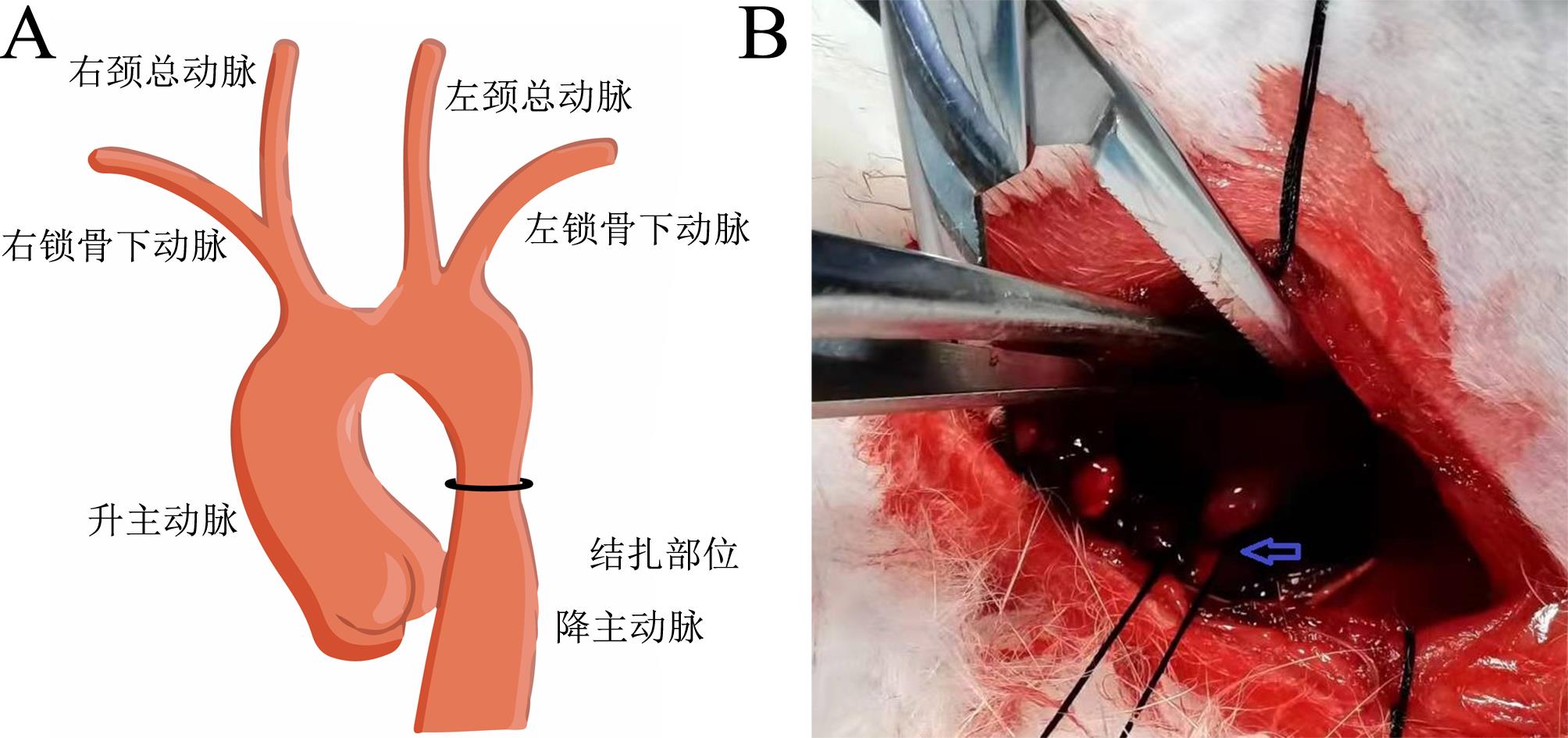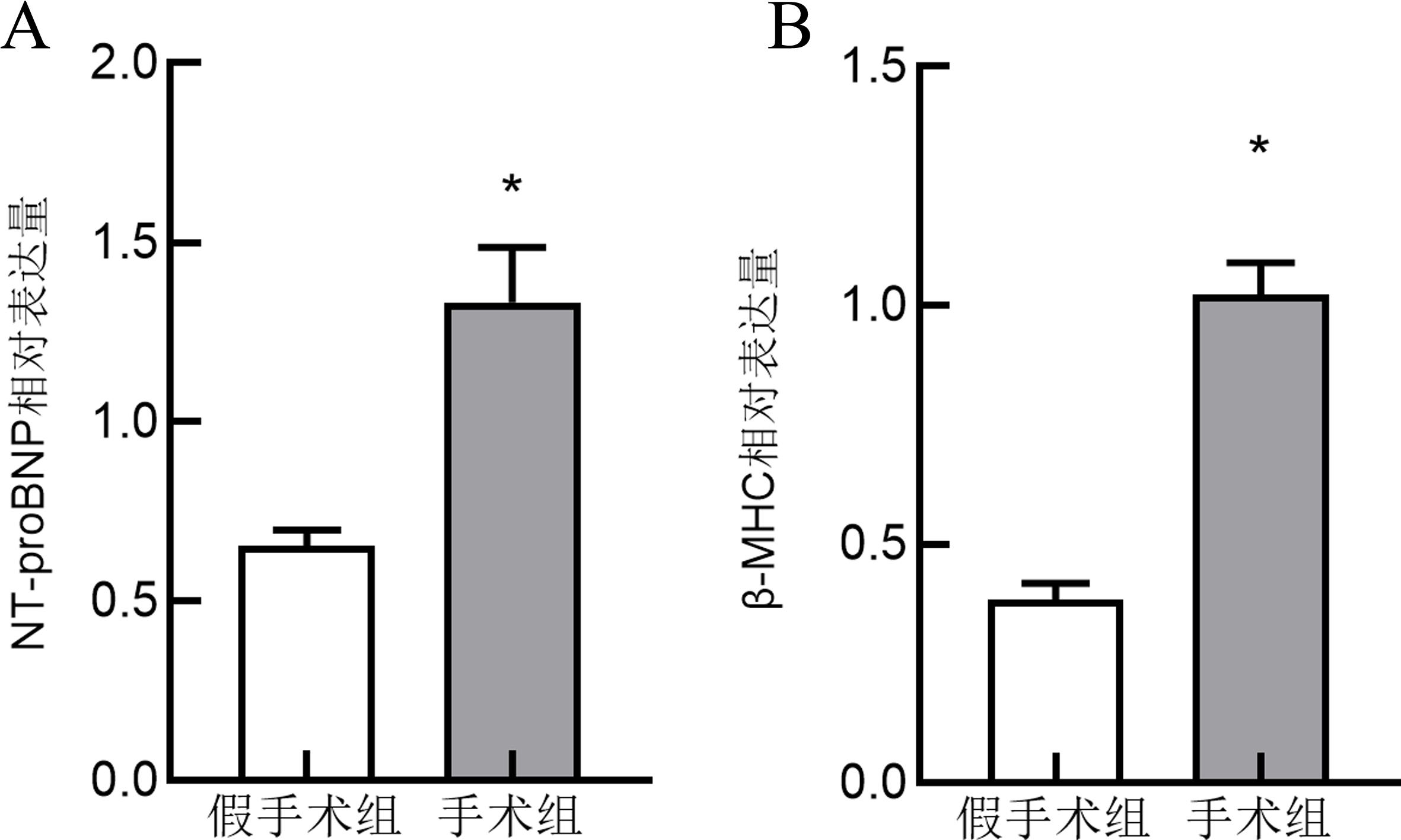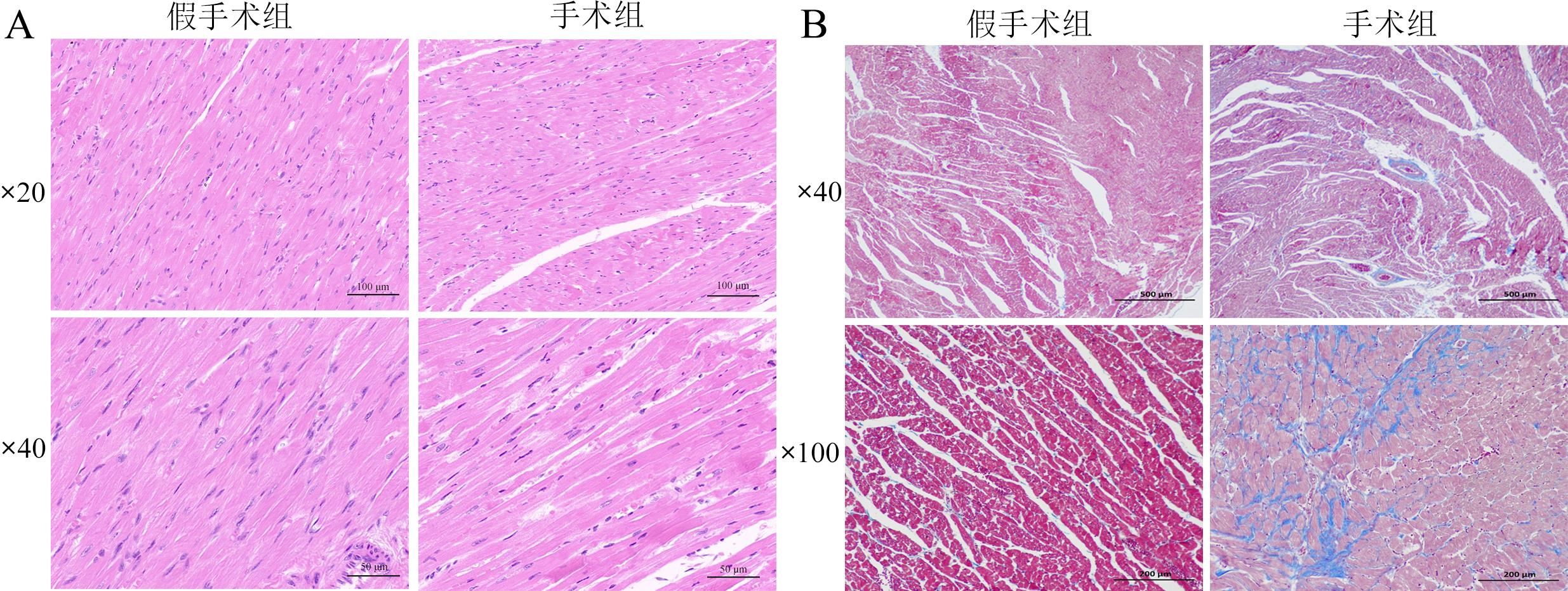
Laboratory Animal and Comparative Medicine ›› 2022, Vol. 42 ›› Issue (5): 401-408.DOI: 10.12300/j.issn.1674-5817.2022.020
• Animal Models of Human Diseases • Previous Articles Next Articles
Qingyi LUO1,2,3( ), Tiling ZHANG2,3,4, Yunchuan DING1,2,3, Jian CHEN1,2,3, Li ZHAO1,2,3, Qinghui WANG1,2,3(
), Tiling ZHANG2,3,4, Yunchuan DING1,2,3, Jian CHEN1,2,3, Li ZHAO1,2,3, Qinghui WANG1,2,3( )(
)( )
)
Received:2022-02-24
Revised:2022-08-04
Online:2022-10-25
Published:2022-11-04
Contact:
Qinghui WANG
CLC Number:
Qingyi LUO, Tiling ZHANG, Yunchuan DING, Jian CHEN, Li ZHAO, Qinghui WANG. Establishment of a Rabbit Heart-failure Model Using Transverse Aortic Constriction[J]. Laboratory Animal and Comparative Medicine, 2022, 42(5): 401-408.
Add to citation manager EndNote|Ris|BibTeX
URL: https://www.slarc.org.cn/dwyx/EN/10.12300/j.issn.1674-5817.2022.020

Figure 1 Sites of surgical ligation of the transverse aortic constriction (TAC) in rabbitsNote:A, Schematic diagram of the site of coarctation of the aorta in TAC; the black circle indicates the ligation site. B, Intraoperative opration diagram of TAC; the arrow shows the ligation site.

Figure 2 Flow velocity of the descending aorta in rabbitsNote: A, The flow velocity at the coarctation of the descending aorta measured in the suprasternal fossa was 2.25 m/s at 8 weeks after transverse aortic constriction operation (n=13); B, The velocity of the descending aorta measured in the suprasternal fossa section was 0.22 m/s (n=10) at 8 weeks after operation in rabbits in the sham-operated group; C, Bar graph comparing the descending aortic flow velocity between the two groups, *P<0.05.
项目 Items | 假手术组 Sham-operation group | TAC手术组 TAC operation group | |||
|---|---|---|---|---|---|
| 4周 4 weeks | 8周 8 weeks | 4周 4 weeks | 8周 8 weeks | ||
| 心率HR/(次·min-1) | 218.00±18.00 | 225.00±15.00 | 251.00±15.00 | 300.00±20.00* | |
| 升主动脉内径AAOd/mm | 4.31±0.74 | 4.52±0.91 | 4.72±0.77 | 7.57±0.88* | |
| 左房舒张末期内径LADd/mm | 3.56±0.84 | 3.75±0.55 | 3.84±0.92 | 4.94±0.42* | |
| 左室舒张末期内径LVEDd/mm | 11.04±1.70 | 12.15±1.51 | 12.55±1.84 | 15.45±1.66* | |
| 左室收缩末期内径LVEDs/mm | 4.64±0.75 | 4.89±0.68 | 5.14±0.92 | 8.83±0.72* | |
| 左室舒张末期室间隔厚度IVSd/mm | 1.73±0.34 | 1.87±0.26 | 2.95±0.41* | 1.51±0.32 | |
| 左室后壁舒张末期厚度LVPWd/mm | 1.55±0.32 | 1.76±0.24 | 2.65±0.56* | 1.23±0.41 | |
| 左室射血分数LVEF/% | 57.33±7.24 | 60.16±11.97 | 58.31±8.74 | 40.29±7.62* | |
Table 1 Changes in cardiac ultrasound parameters at 4 and 8 weeks after operation
项目 Items | 假手术组 Sham-operation group | TAC手术组 TAC operation group | |||
|---|---|---|---|---|---|
| 4周 4 weeks | 8周 8 weeks | 4周 4 weeks | 8周 8 weeks | ||
| 心率HR/(次·min-1) | 218.00±18.00 | 225.00±15.00 | 251.00±15.00 | 300.00±20.00* | |
| 升主动脉内径AAOd/mm | 4.31±0.74 | 4.52±0.91 | 4.72±0.77 | 7.57±0.88* | |
| 左房舒张末期内径LADd/mm | 3.56±0.84 | 3.75±0.55 | 3.84±0.92 | 4.94±0.42* | |
| 左室舒张末期内径LVEDd/mm | 11.04±1.70 | 12.15±1.51 | 12.55±1.84 | 15.45±1.66* | |
| 左室收缩末期内径LVEDs/mm | 4.64±0.75 | 4.89±0.68 | 5.14±0.92 | 8.83±0.72* | |
| 左室舒张末期室间隔厚度IVSd/mm | 1.73±0.34 | 1.87±0.26 | 2.95±0.41* | 1.51±0.32 | |
| 左室后壁舒张末期厚度LVPWd/mm | 1.55±0.32 | 1.76±0.24 | 2.65±0.56* | 1.23±0.41 | |
| 左室射血分数LVEF/% | 57.33±7.24 | 60.16±11.97 | 58.31±8.74 | 40.29±7.62* | |

Figure 3 Doppler echocardiography shows the apical four-chamber view of each groupNote: A, Apical four-chamber view of the sham-operation group 4 weeks after operation; B, Apical four-chamber view of the sham-operation group 8 weeks after operation; C, Apical four-chamber view of the operation group 4 weeks after transverse aortic constriction operation; D, Apical four-chamber view of the operation group 8 weeks after transverse aortic constriction operation.

Figure 4 Changes in the contents of left ventricular heart failure markets 8 weeks after TAC detected by real-time quantitative PCRNote:A, NT-proBNP content at 8 weeks after operation; B, β-MHC content at 8 weeks after operation. Compared with the sham-operation,*P<0.05; n=3.

Figure 5 HE staining and Masson staining of experimental rabbit myocardial tissues in the operation and sham-operation groupsNote: A, HE stained sections of the sham-operation group and the transverse aortic constriction (TAC) operation group at 8 weeks after operation (upper, ×20; lower, ×40); B, Masson’s trichrome stained sections of the sham-operation group and the TAC operation group at 8 weeks after operation (upper, ×40; lower, ×100).
| 1 | KANNEL W B, BELANGER A J. Epidemiology of heart failure[J]. Am Heart J, 1991, 121(3):951-957. DOI:10.1016/0002-8703(91)90225-7 . |
| 2 | CONRAD N, JUDGE A, TRAN J, et al. Temporal trends and patterns in heart failure incidence: a population-based study of 4 million individuals[J]. Lancet, 2018, 391(10120):572-580. DOI:10.1016/S0140-6736(17)32520-5 . |
| 3 | DEALMEIDA A C, VAN OORT R J, WEHRENS X H. Transverse aortic constriction in mice[J]. J Vis Exp, 2010(38):1729. DOI:10.3791/1729 . |
| 4 | WEINBERG E O, SCHOEN F J, GEORGE D, et al. Angiotensin-converting enzyme inhibition prolongs survival and modifies the transition to heart failure in rats with pressure overload hypertrophy due to ascending aortic stenosis[J]. Circulation, 1994, 90(3):1410-1422. DOI:10.1161/01.cir.90.3.1410 . |
| 5 | 黄明, 熊可, 李霄, 等. 心力衰竭动物模型的研究进展[J]. 天津中医药大学学报, 2019, 38(6):534-540. DOI:10.11656/j.issn.1673-9043.2019.06.05 . |
| HUANG M, XIONG K, LI X, et al. Advances in animal models of heart failure[J]. J Tianjin Univ Tradit Chin Med, 2019, 38(6):534-540. DOI:10.11656/j.issn.1673-9043.2019.06.05 . | |
| 6 | HU P, ZHANG D F, SWENSON L, et al. Minimally invasive aortic banding in mice: effects of altered cardiomyocyte insulin signaling during pressure overload[J]. Am J Physiol Heart Circ Physiol, 2003, 285(3): H1261-H1269. DOI:10.1152/ajpheart.00108.2003 . |
| 7 | GROSS D R. Animal models in cardiovascular research[M]. 3rd ed. New York: Springer Science Business, 2009 |
| 8 | 廉洪建, 冯玄超, 啜文静, 等. 创伤较小的小鼠主动脉弓缩窄术的建立[J]. 中国比较医学杂志, 2015, 25(2):42-45, 79. DOI:10.3969.j.issn.1671.7856.2015.002.011 . |
| LIAN H J, FENG X C, CHUAI Wenjing, et al. Establishment of a mouse model of transverse aortic constriction with less invasive injury[J]. Chin J Comp Med, 2015, 25(2):42-45, 79. DOI:10.3969.j.issn.1671.7856.2015.002.011 . | |
| 9 | 李柱锡, 徐利军, 贺行巍, 等. 高频超声在主动脉弓缩窄术诱导小鼠心力衰竭模型中的早期应用评估[J]. 中华实验外科杂志, 2016(6):1611-1613. |
| LI Z X, XU L J, HE X W, et al. High frequency Doppler echocardiography in early evaluation of transverse aortic constriction in-duced heart failure mice[J]. Chin J Exp Surg, 2016(6):1611-1613. | |
| 10 | GIRALDO A, TALAVERA LÓPEZ J, BROOKS G, et al. Transthoracic echocardiographic examination in the rabbit model[J]. J Vis Exp, 2019(148): e59457. DOI:10.3791/59457 . |
| 11 | 徐洪, 臧旺福. 微创建立主动脉弓缩窄动物模型及超声评价[J]. 中华胸心血管外科杂志, 2012, 28(9):544-548. DOI:10.3760/cma.j.issn.1001-4497.2012.09.010 . |
| XU H, ZANG W F. Establishment of mouse model of transverse aortic constriction in a minimally invasive way and echocardiographic assessment[J]. Chin J Thorac Cardiovasc Surg, 2012, 28(9):544-548. DOI:10.3760/cma.j.issn.1001-4497.2012.09.010 . | |
| 12 | MUKOYAMA M, NAKAO K, HOSODA K, et al. Brain natriuretic peptide as a novel cardiac hormone in humans. Evidence for an exquisite dual natriuretic peptide system, atrial natriuretic peptide and brain natriuretic peptide[J]. J Clin Invest, 1991, 87(4):1402-1412. DOI:10.1172/JCI115146 . |
| 13 | NAKAO K, MINOBE W, RODEN R, et al. Myosin heavy chain gene expression in human heart failure[J]. J Clin Invest, 1997, 100(9):2362-2370. DOI:10.1172/JCI119776 . |
| 14 | BOZKURT B, COATS A J S, TSUTSUI H, et al. Universal definition and classification of heart failure: a report of the Heart Failure Society of America, Heart Failure Association of the European Society of Cardiology, Japanese Heart Failure Society and Writing Committee of the Universal Definition of Heart Failure: endorsed by the Canadian Heart Failure Society, Heart Failure Association of India, Cardiac Society of Australia and New Zealand, and Chinese Heart Failure Association[J]. Eur J Heart Fail, 2021, 23(3):352-380. DOI:10.1002/ejhf.2115 . |
| 15 | BAUMGARTNER H, HUNG J, BERMEJO J, et al. Echocardio-graphic assessment of valve stenosis: EAE/ASE recommen-dations for clinical practice[J]. Eur J Echocardiogr, 2009, 10(1):1-25. DOI:10.1093/ejechocard/jen303 . |
| 16 | 贺莉, 肖建民, 付晖, 等. 心肌肥厚心力衰竭兔室性心律失常与氧化应激[J]. 中国心脏起搏与心电生理杂志, 2012, 26(5):427-430. DOI:10.13333/j.cnki.cjcpe.2012.05.016 . |
| HE L, XIAO J M, FU H, et al. Oxidative stress and ventricular arrhythmias in rabbits with myocardial hypertrophy or heart failure[J]. Chin J Cardiac Pacing Electrophysiol, 2012, 26(5):427-430. DOI:10.13333/j.cnki.cjcpe.2012.05.016 . | |
| 17 | 张涛, 高长青, 李力兵. 兔慢性充血性心力衰竭模型的实验研究[J]. 南方医科大学学报, 2010, 30(8):1946-1949. |
| ZHANG T, GAO C Q, LI L B. Establishment of a rabbit model of congestive heart failure[J]. J South Med Univ, 2010, 30(8):1946-1949. | |
| 18 | HORTON J S, BUCKLEY C L, STOKES A J. Successful TRPV1 antagonist treatment for cardiac hypertrophy and heart failure in mice[J]. Channels (Austin), 2013, 7(1):17-22. DOI:10.4161/chan.23006 . |
| 19 | MIRJAFARI H, WELSH P, VERSTAPPEN S M. N-terminal pro-brain-type natriuretic peptide (NT-pro-BNP) and mortality risk in early inflammatory polyarthritis: results from the Norfolk Arthritis Registry (NOAR) [J]. Ann Rheum Dis, 2014, 73(4): 684-90. DOI:10.1136/annrheumdis-2012-202848 . |
| 20 | REDA S M, GOLLAPUDI S K, CHANDRA M. Developmental increase in β-MHC enhances sarcomere length-dependent activation in the myocardium[J]. J Gen Physiol, 2019, 151(5):635-644. DOI:10.1085/jgp.201812183 . |
| [1] | Honghua XU, Tian JIN, Hai WANG, Mengying SHEN, Rui WANG, Yijia ZHOU, Ying TAN. Influence of Corneal Staining in Rabbits on the Evaluation of Eye Irritation Test Results [J]. Laboratory Animal and Comparative Medicine, 2023, 43(3): 307-313. |
| [2] | WEN Fuli. Establishment of Eimeria stiedai Infected Rabbit Model and Nested PCR Assay [J]. Laboratory Animal and Comparative Medicine, 2020, 40(6): 477-482. |
| [3] | CHEN Gaofeng, GAO Zhiling, LOU Weiwei, HUANG Lingying, JIN Shugen. Mice with Liver Fibrosis Based on Acoustic Radiation Force Impulse Imaging [J]. Laboratory Animal and Comparative Medicine, 2020, 40(5): 361-. |
| [4] | CHAI Wenjun, SUN Lei, LIU Xiaoli, PAN Hongyu, GUO Tianan, XU Ye, YAN Mingxia. Establishment of Bone Metastasis Mouse Models through Injecting Human Lung Cancer Cells into Left Ventricle#br# under Ultrasound Guidance#br# [J]. Laboratory Animal and Comparative Medicine, 2020, 40(3): 183-. |
| [5] | DONG Guoju, LIU Jiangang, Guan Jie. The Research Progress of Pathological Characteristics of Animal Models with Heart Failure with Ejection Fraction Preservation [J]. Laboratory Animal and Comparative Medicine, 2020, 40(1): 74-79. |
| [6] | LU Jin, YAN Guo-feng, ZHOU Jin, XIAO Zhong-biao, ZHU Yin-qiu, ZHU Lian, WANG Jing, LI Yao, ZUO Yong. Comparison of Traditional Ultrasound with Speckle Tracking Imaging Technique by Myocardial Infarction Model in Mice [J]. Laboratory Animal and Comparative Medicine, 2018, 38(5): 356-364. |
| [7] | DENG Wei, ZHENG Xin, SHEN Ye-shuai, RUI Min, WANG Fan, LI Sai, GUO Ji-qiang, LIU Hong, GUO Kai-jin. An Experimental Study on Repairing Femoral Condyle Defect by Printing Porous Titanium with 3D Technology in Rabbits [J]. Laboratory Animal and Comparative Medicine, 2017, 37(4): 266-272. |
| [8] | RUI Min, ZHENG Xin, LI Cheng-yu, JIANG Wei, YAO Sheng-cheng, GUO Kai-jin. Application of Digital Three-dimensional Reconstruction Technique in Anatomical Measurement and Investigation of Radius in New Zealand White Rabbits [J]. Laboratory Animal and Comparative Medicine, 2017, 37(4): 273-277. |
| [9] | LI Cai-yun, JIANG Zi-rui, PAN Xue-ying, SONG Zheng, CHANG Yan. The Feasibility of Social Housing for Adult Laboratory Rabbits [J]. Laboratory Animal and Comparative Medicine, 2017, 37(4): 283-287. |
| [10] | CHEN Fang-ming, XU Jian-qin, ZHU Ke-yan, YANG Qin-qin, CHEN Min-li. Determination of Serum Calcium, Phosphorus and Alkaline Phosphatase Levels and Forelimb Bone Mineral Density in Forelimb Malformed White Hair and Black Eyes Rabbits [J]. Laboratory Animal and Comparative Medicine, 2016, 36(1): 19-23. |
| [11] | YUN Shi-feng, DONG Min, ZHAO Zhi-gang, CHEN Li, LIU Biao, TIAN Xiao-yun. Experimental Study on Hematological Parameters of New Zealand White Rabbits at Different Ages [J]. Laboratory Animal and Comparative Medicine, 2016, 36(1): 37-40. |
| [12] | CHEN Fang-ming, LIN Lin, CAI Yue-qin, CHEN Cheng, CHEN Min-li. The Forelimb Bone Mineral Density and Expression of Calcitonin and Osteocalcin in Forelimb Malformed White Hair & Black Eyes Rabbits [J]. Laboratory Animal and Comparative Medicine, 2015, 35(5): 383-389. |
| [13] | GUO Zhong-kun, WANG Ke-zhou, LV Su-jun. Advances in Research of SPF Rabbits [J]. Laboratory Animal and Comparative Medicine, 2014, 34(3): 249-254. |
| [14] | SHEN Xing-jiao, YUE Bing-fei, MA Li-ying. Analysis of the Polymorphism of Mitochondrial DNA Control Region in Three Closed Colonies of Rabbits [J]. Laboratory Animal and Comparative Medicine, 2014, 34(1): 29-34. |
| [15] | ZHAO Xian-zhe, ZENG Gui-gang, QIAO Wei-wei, ZHANG Shen. Changes of Biochemical Indices and Tibia Morphology of Stress Fracture in Rabbits [J]. Laboratory Animal and Comparative Medicine, 2013, 33(2): 135-138. |
| Viewed | ||||||
|
Full text |
|
|||||
|
Abstract |
|
|||||